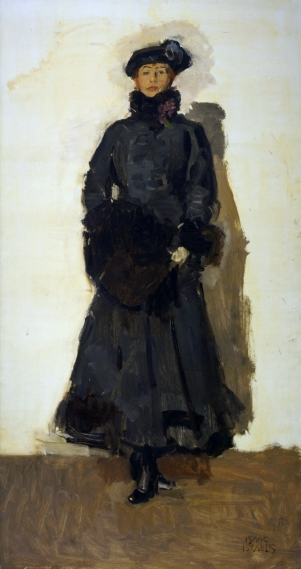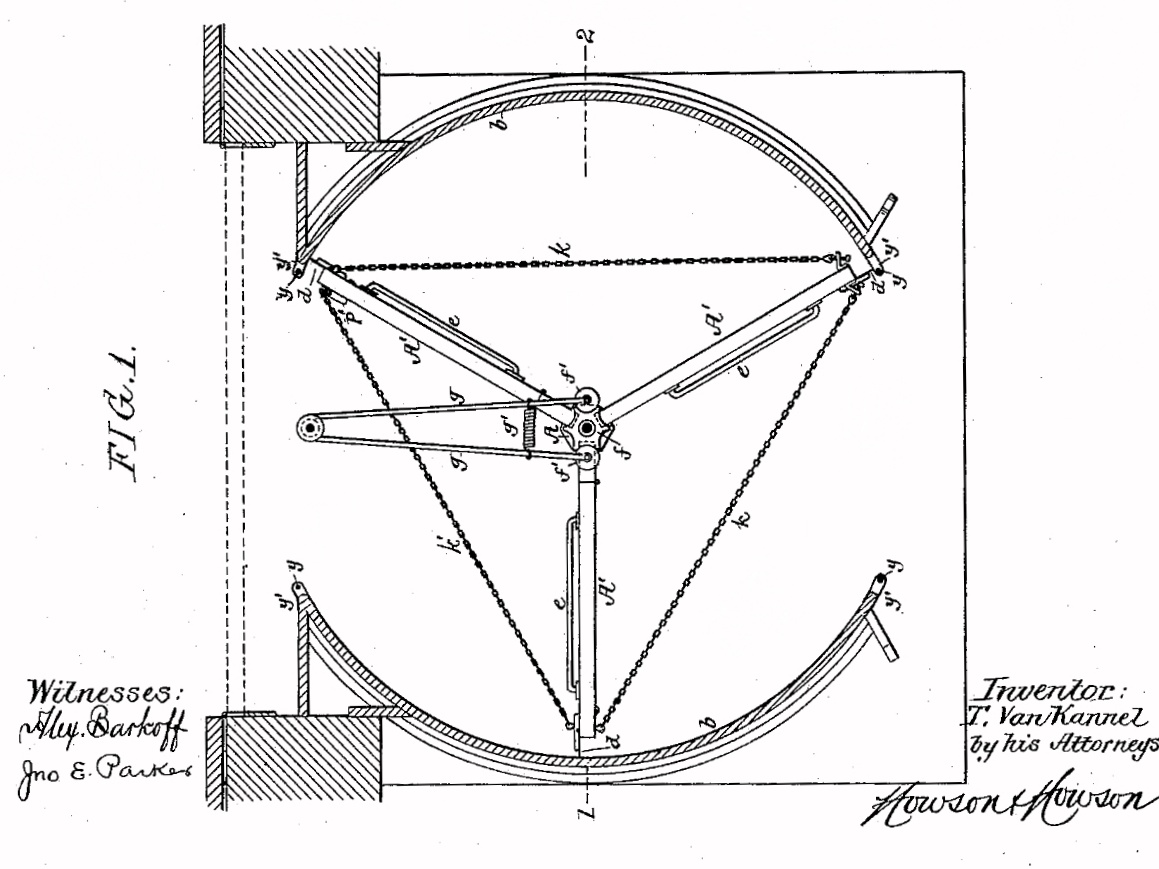 |
| Was this announced as an Arrival or Departure? |
There's been nary a murmur about these pages for simply ages, so Your Correspondent thought to plug the void with a lazy On This Day-kind of entertainment as a little something to be getting on with before a flurry of anticipated bloggish activity evolves beyond the Draft Department: In order to smooth the Comings and Goings of people through history, on this day in 1888 the revolving door was patented by Theophilus Van Kannel.
For thems who may be unfamiliar with this revolutionary idea, (hem hem), I have furnished an extract of the technical drawing for United States Patent number US387571A, (expired on this day in 1905, obv.) above. So with this handy image in mind, Dear Reader, let us put it to good use in a Flying With Hands take on Hatches and Dispatches:
 |
| Mata Hari Isaac Israël, 1916 |
In the Comings Department, on this day in 1876, the mysterious and infamous Dutchwoman Margeretha Geertruida Zelle, a.k.a. Mata Hari, was born. Were she to dress, or, ahem, undress herself in raiments woven in complicated and luxurious brocade, she may have appreciated the endeavours of one man who made possible the mass production of such sumptuous fabric, for her life was a relatively short one and the axiom that good things come to those who wait couldn't thus apply in her case.
 |
| J. M. Jacquard silk portrait, Woven on a programmable loom of his name by Michel-Marie Carquillat, 1839 |
I speak, of course, of inventor Joseph Marie Jacquard, who, in the Goings Department, died on this day in 1834. The Jacquard Loom is quite the fixture in the both the Industrial Revolution and the Computer Revolution, where its punch cards found a temporary home and give fond memories to Computer Scientists of a particular vintage.
English polymath and inventor Charles Babbage, the so-called Father of the Digital Computer, owned a copy of this woven silk portrait of Jacquard. He was mightily interested in this loom and the notion of punch cards and freely adopted their use in the development of his Analytical Engine.
 |
| Charles Babbage's Brain |
As a little aside, and as befits the output of this monstrous brain (which, as he donated it to Science, can be read about here), amongst his many written contributions to the world of science and society is an entrancing 1864 pamphlet extract from his work Passages in the Life of a Philosopher*, entitled A Chapter on Street Nuisances, wherein he rails against the noise pollution of London by the incessant street music.
He lists the "Instruments of torture permitted by the Government to be in daily and nightly use in the streets of London" (viz. brass bands, harpsichords, hurdie-gurdies, drums, bagpipes, psalm singing &c. &c.) and singles out for public shaming the many "Encouragers of Street Music" (viz. tavern-keepers, coffee-shoppes, servants, children, country visitors, sometimes even the occasional titled lady - "but these are almost invariably of recent elevation, and deficient in that taste which their sex usually possesses" - &c. &c.)
He points also to "ladies of elastic virtue and cosmopolitan tendencies, to whom it affords a decent excuse for displaying their fascinations at their own open window" as also being great supporters of this reviled music, so it was fortunate he did not live to witness the "fascinations" of Mata Hari, for he would surely have had a thing or two to add to her reputation.
By the way, Ada Lovelace, (daughter of bad boy Romantic poet Lord Byron) herself the so-called Prophetess of the Computer Age, said in 1843 of her collaborator and friend Charles Babbage's invention, "The Analytical Engine weaves algebraic patterns just as the Jacquard loom weaves flowers and leaves."
Anyhoo, for thems who did not take the quaint subject Textiles & Design in school in the 70s or 80s and study in minute detail the whys and wherefores, I am furnishing a picture below of the invention in question (the Jacquard loom not the Analytical Engine, obv.):
 |
| 1850 Portable Version of the Jacquard Loom |
And for thems who did not work at Big Blue, a.k.a. IBM, or his kith and kin around the same time, I am furnishing a picture below of the thrilling computer punch card complete with bonus tape drives and is that the germ of a regulation comb-over?
 |
| The questions and the answers to Life's Mysteries - and just Getting Stuff Done - Once beheld in humble punched cardboard |
And, before it's all but gone, that's about it for the 7th of August!
* Prefaced thus:
Some men write their lives to save themselves from ennui, careless of the amount they inflict on their readers.
Others write their personal history, lest some kind friend should survive them, and, in showing off his own talent, unwittingly show them up.
Others, again, write their own life from a different motive - from fear that the vampires of literature might make it their prey.
Image credits: 1-4: Wikimedia Commons; 5: via Internet Archive; 6: Flying With Hands; 7: Sotheby's; 8: via Google


Poor Mata Hari, she married a no-goodnick who deserted her and the children, then she had to save herself with nothing but her gorgeous clothes, and talents on stage and in dance. Her so called spying seemed like war time paranoia :(
ReplyDeleteYou are spot on, dear Hels. Resourceful as she was, it all came to nought when a scapegoat was needed at war's end.
DeleteOh Pip, what a bliss to come back to Bavaria and thus being able to use my MacBook (without punched cardboards - they vanished - as that funny comb-over..) and read your so highly interesting blog! (Can you imagine: on my first student's job in a big bank, we had to sort those punched card boards and one computer filled half a high room!)
ReplyDeleteI might borrow your dramatic train-photo - for my new post, yet to write: "A difficult return from Berlin to Bavaria by train" - dedicated to the Deutsche Bahn, which doesn't steal our secrets (as beautiful Mata Hari did) but our time...
Yes, Berlin was filled with Street Nuisances - we were tempted to pay so that they might move on... :-)
Thank you for all these inspirations!!
Dear Britta, the joys of the modern era do lend a gloss to times perhaps not as colourful as the past. Happy to pass the baton on the train photo - Wikimedia Commons will oblige with excellent resolution. It was in recent times a popular image on the interwebs. You'll be happy to know all passengers survived but, alas, a lady flâneur on the street was not so lucky.
DeleteWhen I was very young, I remember seeing reels and reels of punched tape that was thrown off of carnival floats to add to that season's mayhem. Later someone had told me the tapes were fed into computers for something or other. You've shared some fascinating information today.
ReplyDeleteGoodness, Loree, that must have been a sight! The computer nerds of the time must hardly have believed their workaday necessities would end life with such fanfare!
DeleteI didn't know much of this; I learned something!
ReplyDeleteHappy to oblige, dear Ur-spo!
DeleteI have a few old unframed Jacquard portraits somewhere. I suppose I ought to find-out who the subjects are.
ReplyDeleteI hadn't realised Jacquard portraits still existed in the Real World! You must report back, dear Cro.
DeleteWe stayed at a Gothic Mansion in Surrey several years ago that had once been the home of Ada Lovelace. Lord Byron, as you mention was a bad boy, and a bad father to poor Ada, his only legitmate child.
ReplyDeletehttps://wherefivevalleysmeet.blogspot.com/2014/12/horsley-towers.html
You visit simply gorgeous places, dear Rosemary! Thank you for the wonderful photos.
DeleteSo many interesting things - I'm overwhelmed so early in the morning as I await the chimney sweep - whom I must say still does it more like the Mary Poppins character, but without a top hat!!!
ReplyDeleteI've alway adored brocade/jacquard fabrics - growing up with an amazing dressmaker mother, fabrics and the Singer treadle sewing machine were part of our daily life.
When I started my first job in America in 1962 (in Washington D.C.) and was given the tour of my first 'computer room' - I was terrified seeing all that gigantic equipment! Then, given a desk with an IBM Selectric which I'd never used before,
I almost bought a ticket back home to England! How different things are now 60 years later!!!!
Great post dear friend - always worth the wait to see you here making us think, and often reminisce.
Summertime hugs from hot and steamy NC - Mary
Dear Mary, what lovely reminiscences this post sprung forth! And your chimney sweep prompt reminds me I must seek for myself a ticket to the musical Mary Poppins which is in town right now. It's the full Broadway production, according to my tap teacher, and a must see. No-one wants to go with me but it means I can relish the dancing without blushing! Hugs to you!
DeleteI ALWAYS LEARN SOMETHING FROM YOUR WRITINGS!NEVER STOP!!
ReplyDeleteFascinating information.........baci xxx
Thank you, dear Contessa! xx
DeleteEchoing Ur-Spo. And I am all with Charly Babbage and Wilhelm Busch: Musik wird störend oft empfunden / dieweil sie mit Geräusch verbunden. – Music as it's noise-related / is often not appreciated.
ReplyDeleteUff, sorry! Did not notice I was incognito yesterday night. Sure, though, you'd always identify me, anyway, Lady Pipistrello ;-).
ReplyDeleteAh, yes, dear Sean, I did rather fancy I was sent down the Wilhelm Busch rabbit hole courtesy of your erudite self! How did I fail to know about this German icon until now?
DeleteI’m learning so much. A good day. Regine
ReplyDeletewww.rsrue.blogspot.com
Thank you, and welcome, dear Regine.
DeleteImagine how loud those old IBM 'puters were. I can imagine hearing damage was simply a part of the job...
ReplyDeleteWe have come a long way in most respects but, I still dress like Mata Hari !!! XXXX
ReplyDeleteDear Jackie, I expect nothing less! I should, too, if I could get my mitts on such an ensemble! xx
Delete